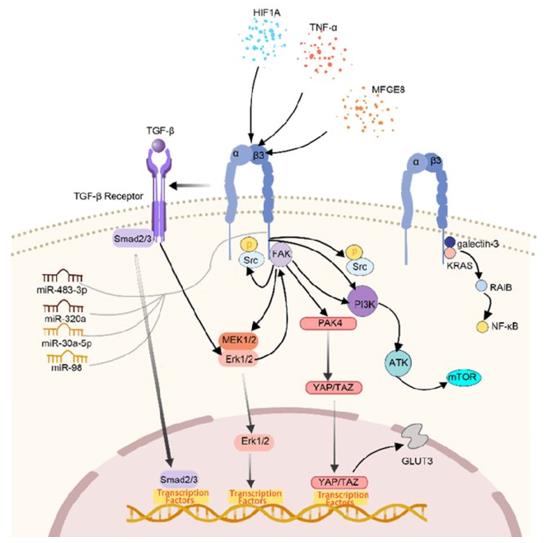What is ITGB3 Protein
Officially known as Integrin Beta-3, the ITGB3 protein is a crucial component in the integrin family. Also recognized by the synonyms CD61 and GPIIIa, this protein plays a pivotal role in cell adhesion and signaling processes. Integrins are transmembrane receptors that mediate cell-extracellular matrix interactions, and ITGB3 specifically belongs to the integrin beta subfamily. Structurally, ITGB3 is characterized by a large extracellular domain, a single transmembrane domain, and a short cytoplasmic tail. Its classification as a beta subunit pairs with various alpha subunits to form functional integrin heterodimers.
Recent research advances in the study of ITGB3 have shed light on its dynamic interactions within the cell. High-resolution imaging techniques have allowed scientists to explore the conformational changes that occur during integrin activation, providing valuable insights into the protein's functional mechanisms.
ITGB3 Biological Functions and Molecular Mechanisms
The biological functions of ITGB3 extend far beyond its structural role. This integrin subunit is primarily involved in platelet aggregation, a critical process in hemostasis and thrombosis. It facilitates the adhesion of platelets to the exposed extracellular matrix, forming a clot to prevent excessive bleeding. Furthermore, ITGB3 participates in angiogenesis, inflammation, and tissue repair by regulating cell migration and proliferation.
At the molecular level, ITGB3 orchestrates signaling cascades through its cytoplasmic tail, influencing various cellular processes. Integrin signaling is intricately connected to the cytoskeleton, impacting cell shape and motility. The engagement of ITGB3 with its ligands initiates a series of events, including the activation of kinases and the modulation of gene expression, highlighting its versatile role in cellular dynamics.

Figure 1. The regulation network of ITGB3 in tumor cells. (Zhu C, et al., 2019)
ITGB3 Related Signaling Pathway
The integrin signaling pathway, with ITGB3 at its core, is a complex network that regulates diverse cellular responses. Upon ligand binding, ITGB3 undergoes conformational changes, triggering the activation of intracellular signaling molecules. Focal adhesion kinase (FAK), mitogen-activated protein kinase (MAPK), and phosphoinositide 3-kinase (PI3K) are key players in this pathway, mediating processes such as cell survival, proliferation, and migration.
Understanding the intricacies of the ITGB3-related signal pathway is crucial for developing targeted therapeutic interventions. Researchers are actively exploring small molecules and antibodies that can modulate ITGB3 activity, offering potential avenues for treating diseases associated with integrin dysfunction.
ITGB3 Related Diseases
The dysregulation of ITGB3 has been implicated in several diseases, emphasizing its significance in maintaining physiological balance. One prominent example is Glanzmann thrombasthenia, a rare inherited bleeding disorder characterized by defective platelet aggregation. Mutations affecting the expression or function of ITGB3 can compromise the integrity of clot formation, leading to prolonged bleeding.
Additionally, studies have linked ITGB3 to certain cancers, emphasizing its role in tumor progression and metastasis. Altered expression patterns of ITGB3 have been observed in various cancer types, underscoring its potential as a prognostic marker and therapeutic target.
ITGB3's Applications in Biomedicine
The unique properties of ITGB3 make it an attractive target for biomedical applications. In the realm of diagnostics, the detection of ITGB3 expression levels can serve as a diagnostic marker for certain diseases, including cancers and platelet disorders. Advanced imaging techniques, such as positron emission tomography (PET) and magnetic resonance imaging (MRI), are being employed to visualize ITGB3 expression in vivo, aiding in disease diagnosis and monitoring.
In vaccine development, ITGB3 is being explored as a potential antigen for eliciting immune responses. Researchers are investigating the feasibility of targeting ITGB3-expressing cells to enhance immune recognition, providing a novel approach to cancer immunotherapy.
On the therapeutic front, drugs targeting ITGB3 are being developed to modulate its function in diseases such as thrombosis and cancer. Antiplatelet medications, including integrin inhibitors, are utilized to prevent excessive clotting and reduce the risk of cardiovascular events.
Recommended Products
| Cat.No. | Product Name | Species | Source (Host) | Tag |
|---|---|---|---|---|
| ITGAV & ITGB3-738H | Active Recombinant Human ITGAV & ITGB3 Protein, His-Avi-tagged, Biotinylated | Human | HEK293 | His/Avi |
| ITGB3-2372H | Recombinant Human ITGB3 Protein (Glu134-Glu384), His tagged | Human | E.coli | His |
| ITGB3-151H | Recombinant Human ITGB3 Protein, DYKDDDDK-tagged | Human | Human cells | DYKDDDDK |
| ITGB3-2940H | Recombinant Human ITGB3 protein, His-tagged | Human | E.coli | His |
| ITGB3-4733H | Recombinant Human ITGB3 Protein, Myc/DDK-tagged, C13 and N15-labeled | Human | HEK293T | Myc/DDK |
| ITGb3-3269H | Recombinant Human ITGb3 protein, His-tagged | Human | HEK293 | His |
| ITGB3-5921HFL | Recombinant Full Length Human ITGB3 protein, Flag-tagged | Human | Mamanlian cells | Flag |
| ITGB3-4327H | Recombinant Human ITGB3 Protein (Met1-Asp718), C-His tagged | Human | Mammalian cells | C-His |
| ITGB3-1165H | Recombinant Human ITGB3 Protein (Glu134-Glu384), N-His tagged | Human | E.coli | N-His |
Reference
- Zhu C, et al. ITGB3/CD61: a hub modulator and target in the tumor microenvironment. American Journal of Translational Research. 2019, 11(12): 7195.

